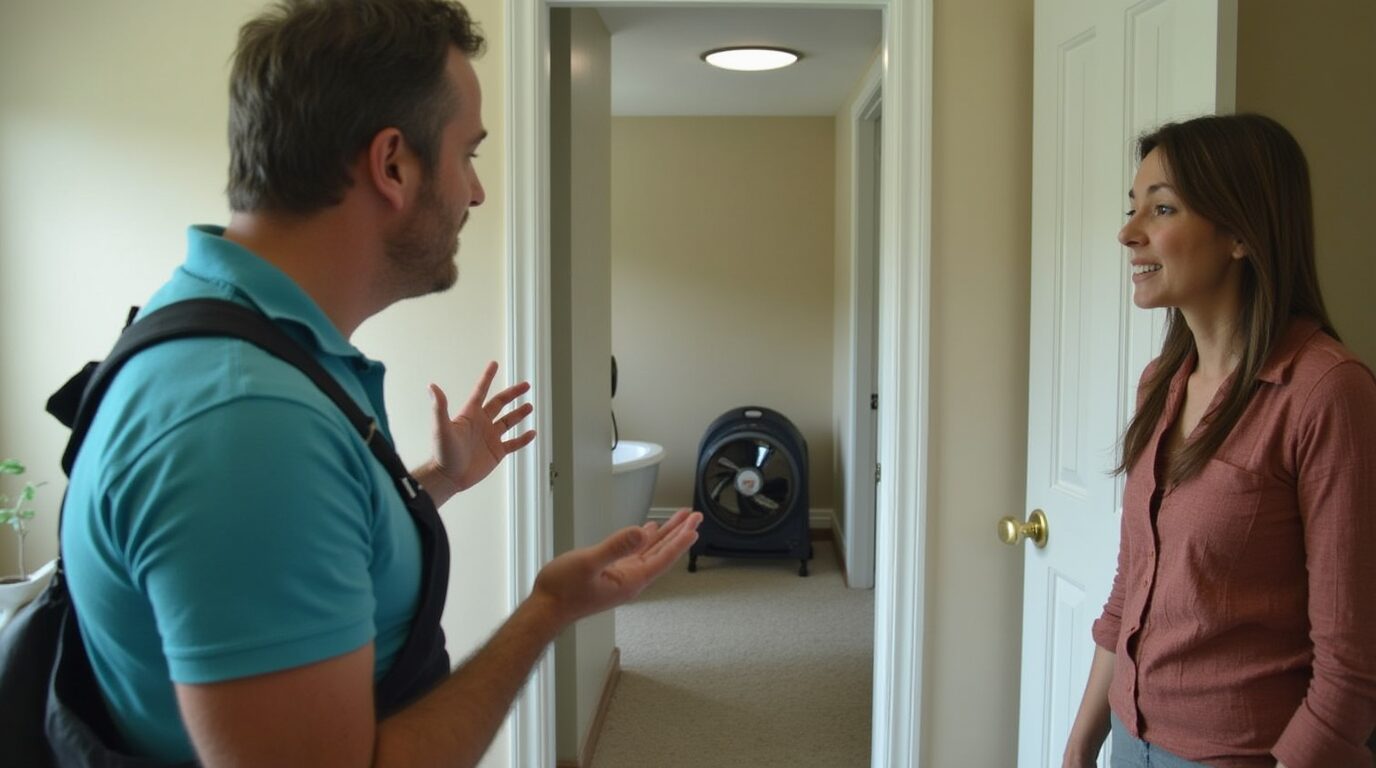
What To Do When A Toilet Overflow Damages Your Bathroom
Toilet overflows are one of the most common causes of water damage in bathrooms, and they can lead to costly repairs and potential health hazards if not addressed immediately. Overflowing toilets can result from a variety of issues, from simple blockages to more complex plumbing problems.
Knowing how to react quickly can prevent further damage and reduce the risk of mould growth, structural issues, and contamination.
Let’s get right into it!
Common Causes Of Toilet Overflows
Blocked Drains And Sewer Backups
The most common cause of a toilet overflow is a blockage in the plumbing system. This could be a clog in the toilet itself or deeper within the pipes. Sewer backups often occur when there is a significant obstruction in the sewer line, such as tree roots, debris, or a buildup of waste. These blockages can cause the toilet to back up and overflow when flushed.
Faulty Float Mechanisms And Valve Issues
Another cause of toilet overflows is a malfunction in the float mechanism or fill valve inside the tank. If the float is stuck or the valve fails to shut off, water continues to fill the tank, leading to an overflow. This issue is less common but still requires attention, as it can waste a significant amount of water and cause bathroom flooding.
Improper Use Of Toilet Paper Or Foreign Objects
Excessive amounts of toilet paper or non-flushable items can quickly clog the toilet and lead to an overflow. Common culprits include sanitary products, wipes, and cleaning materials. These items can create blockages that prevent the water from draining, causing the toilet to overflow.
Immediate Steps To Take After An Overflow
Shutting Off The Water Supply Quickly
The first step in dealing with a toilet overflow is to stop the flow of water. Locate the water supply valve behind or beside the toilet and turn it off immediately. This will prevent further flooding and give you time to assess the situation and begin clean-up.
Containing The Spread Of Water
After turning off the water, you need to contain the water to prevent it from spreading to other areas of the bathroom or home. Use towels or absorbent materials to soak up excess water. If possible, block doorways or seal off the bathroom to prevent water from reaching adjacent rooms.
Removing Excess Water And Preventing Slip Hazards
Once you have contained the overflow, begin removing the standing water. A wet/dry vacuum or mop can help quickly clear the area. Be cautious of slip hazards during this process, as water can make the bathroom floor dangerously slippery.
Assessing And Documenting The Damage
Checking For Hidden Water Damage
Examine the affected area for hidden water damage, especially in places like the subfloor or behind walls. Water can seep into these spaces and cause significant damage if left untreated. If the overflow was substantial, it’s essential to inspect the area for signs of moisture under flooring, along the baseboards, or in the drywall.
Taking Photos For Insurance Claims
Documenting the damage is crucial for insurance purposes. Take clear photographs of the affected areas, including any visible damage to the toilet, flooring, walls, or ceiling. This will help provide evidence of the damage and make the claims process smoother.
Signs Of Mould And Structural Issues
After the overflow, watch for signs of mould growth, which can occur in as little as 24 to 48 hours in moist environments. Look for discolouration or a musty smell in the bathroom. Additionally, if the water has caused significant structural damage, it may be necessary to call in a professional to inspect the integrity of the floorboards or support beams.
Cleaning And Sanitizing The Area Safely
Using The Right Disinfectants
Because toilet overflow water can be contaminated, it’s important to use the right disinfectants during cleaning. A bleach solution or an industrial-strength disinfectant should be used to sanitize all affected surfaces. Focus on areas that came into direct contact with the water, such as the toilet, flooring, and walls.
Proper Drying Techniques For Floors And Walls
Once the cleaning process is complete, it’s important to dry the area thoroughly. Use fans, dehumidifiers, and open windows to ensure proper ventilation. Any moisture left behind can lead to mould growth or cause further damage to your bathroom materials. If the walls or floorboards are wet, consider using a dehumidifier to speed up the drying process.
When To Dispose Of Contaminated Materials
If the overflow water has soaked into materials like carpet, insulation, or wooden floorboards, these materials may need to be removed and replaced. Contaminated materials can harbour bacteria and pose health risks. When in doubt, consult a professional restoration service to assess whether materials can be salvaged or need to be discarded.
When To Call A Professional Restoration Service
The Benefits Of Expert Water Damage Assessment
In cases of significant toilet overflow damage, it may be necessary to contact a professional water damage restoration company. These experts have the tools, knowledge, and experience to assess the damage properly, identify hidden moisture, and prevent further issues.
Restoration Process: Drying, Repair, And Prevention
A restoration service will carry out a thorough drying process, including using industrial-grade dehumidifiers and fans. They will also repair any structural damage and ensure the bathroom is restored to its original condition. Professional services can also advise on how to prevent future overflows by checking for blockages or issues in the plumbing system.
Insurance Considerations And Emergency Response
If you have insurance coverage for water damage, a professional restoration service can work with your insurer to make the claims process smoother. Many restoration companies are familiar with insurance procedures and can help ensure your claim is processed efficiently.
FAQ
What Should I Do Immediately After A Toilet Overflow?
The first step is to turn off the water supply valve to stop the flow of water. Afterward, contain the water to prevent it from spreading, then begin removing excess water from the area.
Is Toilet Water Considered Hazardous?
Yes, toilet water can be contaminated with bacteria and other pathogens. It is crucial to disinfect the affected area thoroughly after an overflow.
Can I Use A Shop Vac To Clean Up The Overflow?
Yes, a wet/dry vacuum can be an excellent tool for removing standing water. However, be sure to disinfect the vacuum after use, as it may come into contact with contaminated water.
How Long Does It Take To Dry A Flooded Bathroom?
The drying time depends on the extent of the water damage. Typically, it may take 24 to 48 hours for a bathroom to dry completely using fans and dehumidifiers.
Will My Insurance Cover Toilet Overflow Damage?
Most homeowner’s insurance policies cover water damage from toilet overflows, but you should check the details of your policy to confirm coverage for this type of incident.
What Are Signs That Mould Is Forming?
Common signs include discolouration, musty smells, or visible growth on surfaces like walls and floors. Mould typically starts within 24–48 hours in a damp environment.
Do I Need To Replace Bathroom Flooring After Flooding?
If the flooring material is heavily soaked, such as carpet or laminate, it may need to be replaced. Harder materials like ceramic tiles may only need cleaning and drying.
How Do I Prevent Future Toilet Overflows?
Regularly clean the toilet and pipes to prevent blockages. Avoid flushing non-flushable items, and ensure your plumbing system is inspected and maintained to catch any potential issues before they cause overflows.
Should I Remove The Toilet To Inspect The Subfloor?
In cases of significant water damage, it may be necessary to remove the toilet to check the subfloor for water damage. This step helps ensure no moisture is trapped beneath the toilet, which could lead to mould growth.
When Should I Hire A Professional Restoration Service?
If the water damage is extensive or if you are unsure about the extent of the damage, it’s best to call a professional restoration service. They have the tools and expertise to ensure proper cleaning, drying, and repairs.
Conclusion
Toilet overflows can cause serious damage to your bathroom, but quick action can help prevent further issues. Shutting off the water supply, cleaning and sanitising the area, and assessing the damage early can save you time and money in repairs. For significant damage, do not hesitate to call a professional restoration service to ensure your home remains safe and dry. Taking the right steps now can prevent long-term damage and help you maintain a healthy, safe bathroom.
If you have any questions about our article, “What To Do When A Toilet Overflow Damages Your Bathroom” or need water damage restoration services contact us at 1-833-WE-DRY-IT any time 24/7/365 all the time or connect with us on social media, we’re there when you need us!
Related Posts
Mould Removal Restoration Articles
5 Signs You Have Mould Growing In Your Walls
“Can I Remove Mould Myself?” Our Mould Removal Experts Have Answers
7 Must-Know Reasons Why You Should Get A Mould Inspection Before Buying A House
Does Mould Attract Bugs? Yes And Here’s What Kind And Why
How To Remove Mould From The Attic [Mould Prevention Tips Inside]
How Rain Causes Mould Growth-Prevention Tips Included
Must-Know Tips: How To Remove Mould In Your Basement
Water Damage Restoration Articles
What you can expect from a fire damage restoration company
Water damage prevention tips from the most common problems we’ve seen
Top causes of water damage in commercial buildings and how to find them
Must-know water damage tips: What to do after your house floods
What does good water damage restoration look like?
DIY water damage restoration and the hidden dangers
How to choose the right water damage company
Flast floods: What to do before, during and after a flash flood
What to do when your attic leaks?
Fire Damage Restoration Articles
How to clean up after a house fire
Fire damage restoration checklist
Fire damage tips: 6 hazards property owners miss
How smoke from fires can negatively affect your health
What are the most common causes of house fires?
10 helpful smoke damage cleaning tips
Related Water Damage Services
Fire damage restoration services
Water damage restoration services
Emergency cleanup services
Mould removal services
Weather damage services



